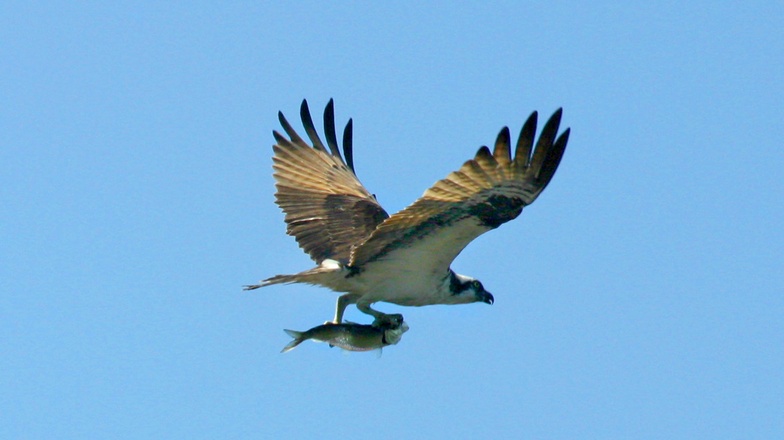I recently received a letter from a reader who asked an intriguing question about ospreys. Noting that osprey populations are rebounding from their dramatic crash from DDT contamination, the reader has noticed that ospreys often nest on telephone poles, power-line towers and even channel markers along our coastal waterways. He asked if we should be making artificial nest platforms to help the osprey population continue to grow.
This question caused me to think about the way we use our limited conservation dollars. I’ll address some of these general thoughts before giving my view on the question of the need for osprey platforms.
Wildlife conservation can be boiled down to two approaches. First, a tract of land or body of water with outstanding diversity may be purchased and protected in perpetuity.
Often, a charismatic animal of the community serves as the ambassador of the habitat to the public at large. Who can resist a giant panda or a spotted owl?
setting aside diverse habitat, all of the species in the area, including inconspicuous ones like insects, spiders and other invertebrates are all protected along with the more obvious vertebrates and plants.
The alternative approach is to develop and implement a conservation approach tailored to a single species. This approach requires detailed information on the factor that limits the population. Consider a bird that is limited by food availability. Providing nesting sites or cover to cut down on predation will not be effective conservation practices.
Food provision is the way to allow the population to grow.
Understanding the limiting factor of a population takes lots of time and effort.
Here’s a cautionary tale. Loggerhead turtles have been on the threatened species list since 1978, so are a concern to marine conservationists. Female loggerhead turtles come ashore on sandy beaches to lay 100 or more eggs above the high tide level. The eggs incubate beneath the sand, warmed by the sun, and hatch out later in the summer. The hatchlings then find their way down to the water’s edge and begin their lives at sea.
Raccoons, dogs and other predators may destroy loggerhead turtle nests.
Hatchlings are at risk to bird and mammal predators as they seek to move down the beach to the sea.
In an effort to help the populations, beach patrols have been set up along beaches in the southeastern and gulf states. Volunteers map the location of nests, transplant eggs to safer places if necessary and guard the hatchlings as they make their way down the beach. Some beach patrols report that 90 percent of the eggs laid along a stretch of beach produce hatchlings that make it to the water.
About 20 years ago, some population biologists started to collect survivorship information for different ages of loggerhead turtles, from the egg stage to the oldest adults. The same sort of technique is used by insurance companies to develop actuarial tables. Those tables need to be pretty accurate or an insurance company will go bankrupt.
From the turtle model, the biologists found that the bottleneck for the species was the 5- to 7-year-old subadult turtles that were often drowned when caught in the nets of shrimp trawlers. That finding led to the development of Turtle Excluder Devices (TEDs) that must be used by shrimp trawlers in the Gulf of Mexico.
The authors found that even if 100 percent of loggerhead turtle eggs survived, the population would still show a decline. Sure, the beach patrols do help increase loggerhead turtle survival but conservation dollars and time might be better spent helping protect the 5- to 7-year-old turtles.
Returning to ospreys, we do not have definitive information on the factor that limits osprey population growth. Some have argued that the limiting resource is either food or nesting sites.
We do know that ospreys readily adopt artificial nest platforms. Such platforms are generally more stable and safer than the natural nesting areas (usually dead or living trees). Nesting success is generally twice as high in nests on artificial sites compared to natural sites.
Erecting artificial nest platforms is an effective way to get ospreys to nest in areas where they had not nested previously. Because ospreys are not territorial, it is possible to establish colonies pretty quickly.
Still, we do not know if nest sites limit the populations. Ospreys may choose artificial nest platforms for nesting because they are superior to natural sites.
However, that does not mean that natural sites are not sufficient for the population.
Pending further research, I am skeptical of the need to invest significant funding for artificial nests for ospreys.
Herb Wilson teaches ornithology and other biology courses at Colby College. He welcomes reader comments and questions at:
whwilson@colby.edu
Send questions/comments to the editors.



Success. Please wait for the page to reload. If the page does not reload within 5 seconds, please refresh the page.
Enter your email and password to access comments.
Hi, to comment on stories you must . This profile is in addition to your subscription and website login.
Already have a commenting profile? .
Invalid username/password.
Please check your email to confirm and complete your registration.
Only subscribers are eligible to post comments. Please subscribe or login first for digital access. Here’s why.
Use the form below to reset your password. When you've submitted your account email, we will send an email with a reset code.